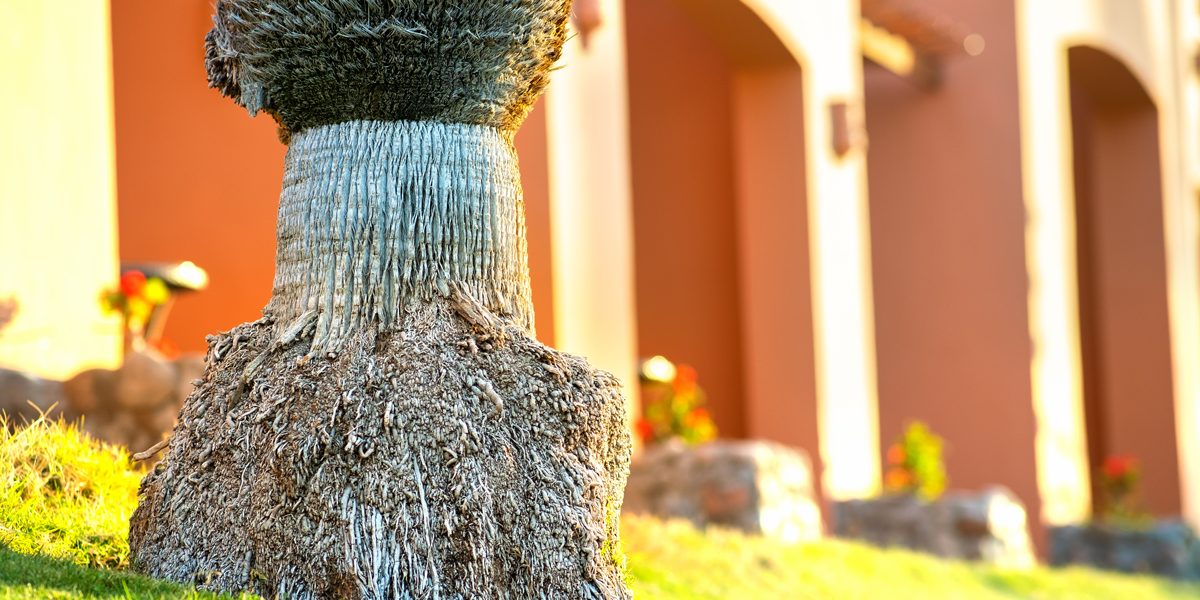Palm trees are known for their distinctive and often impressive root systems, which play a crucial role in supporting these tall, tropical plants. Here are some key characteristics of palm tree root systems:
- Fibrous Root System: Most palm trees have a fibrous root system, which is composed of many thin roots that grow in all directions from the base of the tree. These roots are relatively shallow and spread out to anchor the palm securely in the soil.
- Adventitious Roots: Palm trees often produce adventitious roots. These are specialized roots that form at or just above the soil surface, enabling the tree to absorb water and nutrients efficiently from rainfall, surface water, and moisture in the air.
- No Taproot: Unlike many other types of trees, palm trees typically lack a central, deep taproot. Instead, they rely on the dense network of fibrous roots to provide stability and gather nutrients.
- Rhizomatous Roots (Some Varieties): Some palm species have a rhizomatous root system, which means they produce underground horizontal stems called rhizomes. These rhizomes can give rise to new shoots, allowing the palm to form clumps or colonies.
- Root Growth: Palm tree roots grow primarily in the upper layers of soil, often within the top 36 inches (approximately 91 centimeters) of soil depth. The extensive network of shallow roots helps palms anchor themselves in loose, sandy soils commonly found in their natural habitats.
- Salt Tolerance: Many palm species are salt-tolerant, which is advantageous when they grow in coastal regions where the soil may have a high salt content. The fibrous root system can help these palms extract water from saline soils.
- Support for Tall Trunks: The fibrous root system provides stability and support for the tall trunks of palm trees. This adaptation allows them to withstand strong winds and storms common in tropical and subtropical regions.
- No Lateral Roots: Palm trees generally lack thick, lateral roots that extend far from the tree’s base. The extensive root network is concentrated near the trunk, providing stability but limited lateral spread.
- Symbiotic Relationships: Palm trees often form symbiotic relationships with mycorrhizal fungi. These fungi help enhance nutrient uptake and improve the palm’s ability to thrive in nutrient-poor soils.
- Adaptation to Arid Climates: Some palm species have adapted to arid and desert climates, where they can access shallow groundwater with their extensive root systems.
It’s important to note that palm trees come in various species, each with its own specific growth habits and adaptations. While the fibrous root system is common among many palm varieties, there can be variations depending on the species and the environmental conditions in which they grow. Understanding the specific needs of the palm species in your area is important for proper care and maintenance.
Palm Tree Roots
Palm tree root systems serve these thriving trees quite well. Whenever the tree grows, the area that goes into the ground is referred to as the initiation zone. This zone is where the roots start to form. These roots will be very fine but sprawl horizontally, forming a root ball. More roots will develop from this root ball.
These roots continuously spread horizontally to retrieve as much moisture and nutrients as possible. A horizontal root system also helps to anchor the palm trees to the ground. This system comes in handy when the trees are faced with high winds or other inclement weather conditions.
Palm Tree Roots Grow Horizontally
Rather than growing straight down like most tree roots, palm tree roots prefer to grow horizontally. The roots will spread out within the topsoil area, usually limited to 12-36 inches deep. The roots will spread far away from the tree’s trunk in an effort to absorb as much water and nutrients as possible. If you are planning to plant some large palm tree cultivars, it’s suggested to keep them 11-12 feet apart and away from any underground drainage pipes.
The Root Ball
Not growing as large as the tree itself, the root ball will keep the same circumference even as it grows longer. As roots expand horizontally away from the trunk, a root ball will form. For a short palm tree, measuring around 16 feet, the diameter of the ball should be about 24 inches.
Phoenix Valley Palm Tree for Sale
If you’re looking for the best stock of palm trees in the valley A&P Nursery can help! With 4 east valley locations our team can help you find the perfect trees and plants to take your landscape from ordinary to extraordinary. In addition to selling trees and plants we partner with companies that will plant your trees or plants and care for them as long as you wish. That means all you need to do to get your landscape looking it’s best is stop by and browse our trees, choose your favorite, and leave the rest of the work to the pros.
Call or stop by one of our 4 locations today!





